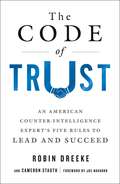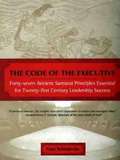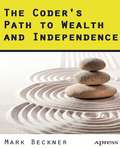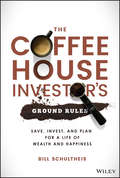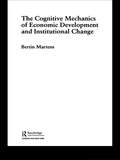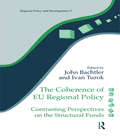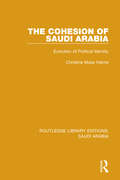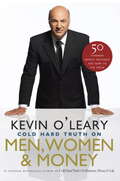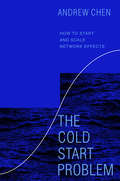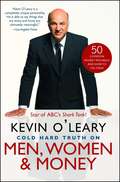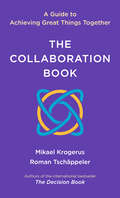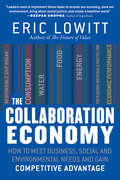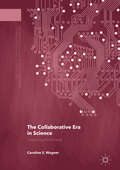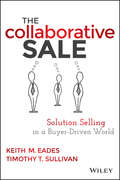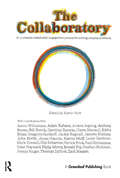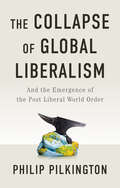- Table View
- List View
The Code of Trust: An American Counterintelligence Expert's Five Rules to Lead and Succeed
by Cameron Stauth Joe Navarro Robin DreekeA counterintelligence expert shows readers how to use trust to achieve anything in business and in life.Robin Dreeke is a 28-year veteran of federal service, including the United States Naval Academy, United States Marine Corps. He served most recently as a senior agent in the FBI, with 20 years of experience. He was, until recently, the head of the Counterintelligence Behavioral Analysis Program, where his primary mission was to thwart the efforts of foreign spies, and to recruit American spies. His core approach in this mission was to inspire reasonable, well-founded trust among people who could provide valuable information.The Code of Trust is based on the system Dreeke devised, tested, and implemented during years of field work at the highest levels of national security. Applying his system first to himself, he rose up through federal law enforcement, and then taught his system to law enforcement and military officials throughout the country, and later to private sector clients. The Code of Trust has since elevated executives to leadership, and changed the culture of entire companies, making them happier and more productive, as morale soared.Inspiring trust is not a trick, nor is it an arcane art. It’s an important, character-building endeavor that requires only a sincere desire to be helpful and sensitive, and the ambition to be more successful at work and at home. The Code of Trust is based on 5 simple principles:1) Suspend Your Ego2) Be Nonjudgmental3) Honor Reason4) Validate Others5) Be GenerousTo be successful with this system, a reader needs only the willingness to spend eight to ten hours learning a method of trust-building that took Robin Dreeke almost a lifetime to create.
The Code of the Executive
by Don SchminckeMore than a thousand years ago, a group of business executives developed a set of principles for organizational leadership in a competitive market. Those executives were the samurai of ninth-century Japan, and their rigid code of ethics, known as bushido, was one of the most effective frameworks for management in history. The Code of the Executive is business adviser Don Schmincke's modern interpretation of the Code of the Samurai--ancient wisdom written for today's corporate warriors. These principles provide a dynamic system of practical and moral training for effective leadership. In addition to interactive strategies for relating to the business world, this philosophy provides at its core a guide to the inner development necessary for consistent and long-term success. A terrific gift for a friend, relative, new graduate, or business associate, The Code of the Executive is filled with relevant wisdom and offers an enlightened path to business fulfillment. .
The Coder's Path to Wealth and Independence
by Mark BecknerDevelopers, programmers, technical architects, and consultants: You are highly skilled and have deep commitment to your craft as well as the motivation to excel. It's time to step away from the perceived security of a full-time salaried position, or a marginally successful solo business, and step into a world of freedom, independence, and wealth. With your current technical skills, and an open mind, you can rapidly build a highly successful and ethical business--and on your own terms. The Coder's Path to Wealth and Independence explains how. Mark Beckner, himself, a highly successful itinerant developer, shows you how to transform yourself from a skilled programmer into a highly creative and effective businessperson leveraging the skills you already have. You will learn to create opportunities where none have existed, create value for yourself and those you work with, substantially increase your income, define your ideals, and realize your dreams. By utilizing the unique strategies outlined in The Coder's Path to Wealth and Independence to build your practice, you will find your path to personal, professional, and financial prosperity. The Coder's Path to Wealth and Independence will show you how to: Work from wherever you want Use your technical skills to create a high-revenue, highly independent business Learn the skills of the "rainmaker" to acquire new projects and clients Operate under various fee models, allowing you to increase your wealth and your freedom Rapidly create proposals and contracts Manage projects and execute on your goals with greater skill than ever In short, this book will help you discover a variety of powerful and unique approaches to business that will allow you be highly successful--where, how, and whenever you want. What you'll learn How to take your technical skills and create a high revenue, highly independent business based on them How to work from wherever you want, and stay in constant motion, on your terms How to create opportunities through unique approaches to client acquisition and advertising How to focus on self-mastery and discipline in order to create a thriving practice How to implement a powerful business model, tailored to solo developers and technical consultants, that enables you to work when, where, and how you want Who this book is for Coders, architects, and technical consultants, and anyone in the world of technology all have the core skills required to follow this path to freedom and riches. This is a guide targeted at people who want to create and grow thriving and rewarding solo, technically focused practices. Table of Contents Chapter 1: Travel: The Power of Staying in Motion Chapter 2: Skills: The Nature of Programming and Business Chapter 3: Discipline and Education: The Importance of Continuous Improvement Chapter 4: Ethics: The Foundation of Relationships and Business Chapter 5: Structuring Your Business: Protecting Yourself Chapter 6: Advertising and Marketing: The Science of Lead Creation Chapter 7: Prospecting and Sales: The Art of Rainmaking Chapter 8: Proposals and Contracts: Trust, Flexibility and Simplicity Chapter 9: Fees and Income: Creating a High Dollar Revenue Stream Chapter 10: Goal Setting: The Engine Behind Your Success Chapter 11: Growth and Expansion: Handling Success Chapter 12: Investing in Your Business and Utilizing Wealth: The Abundance Mentality Chapter 13: Health: Personal Vitality and the Impact on Your Business Chapter 14: Freedom through Business: Wealth, Dreams, and Independence
The Coffee Bean: A Simple Lesson to Create Positive Change (Jon Gordon)
by Jon Gordon Damon WestFrom bestselling author Jon Gordon and rising star Damon West comes The Coffee Bean: an illustrated fable that teaches readers how to transform their environment, overcome challenges, and create positive change. Life is often difficult. It can be harsh, stressful, and feel like a pot of boiling hot water. The environments we find ourselves in can change, weaken, or harden us, and test who we truly are. We can be like the carrot that weakens in the pot or like the egg that hardens. Or, we can be like the coffee bean and discover the power inside us to transform our environment. The Coffee Bean is an inspiring tale that follows Abe, a young man filled with stress and fear as he faces challenges and pressure at school and home. One day after class, his teacher shares with him the life-changing lesson of the coffee bean, and this powerful message changes the way he thinks, acts, and sees the world. Abe discovers that instead of letting his environment change him for the worse, he can transform any environment he is in for the better. Equipped with this transformational truth, Abe embarks on an inspirational journey to live his life like the coffee bean. Wherever his life takes him, from school, to the military, to the business world, Abe demonstrates how this simple lesson can unleash the unstoppable power within you. A delightful, quick read, The Coffee Bean is purposely written and designed for readers of all ages so that everyone can benefit from this transformational lesson. This is a book and message that, when read and shared, has the power to change your life and the world around you. You just have to decide: are you a carrot, egg, or coffee bean?
The Coffee Book: Anatomy of an Industry from Crop to the Last Drop (A\bazaar Book Ser.)
by Nina Luttinger Gregory DicumA history of coffee from the sixth century to Starbucks that&’s &“good to the last sentence&” (Las Cruces Sun News). One of Library Journal&’s &“Best Business Books&” This updated edition of The Coffee Book is jammed full of facts, figures, cartoons, and commentary covering coffee from its first use in Ethiopia in the sixth century to the rise of Starbucks and the emergence of Fair Trade coffee in the twenty-first. The book explores the process of cultivation, harvesting, and roasting from bean to cup; surveys the social history of café society from the first coffeehouses in Constantinople to beatnik havens in Berkeley and Greenwich Village; and tells the dramatic tale of high-stakes international trade and speculation for a product that can make or break entire national economies. It also examines the industry&’s major players, revealing the damage that&’s been done to farmers, laborers, and the environment by mass cultivation—and explores the growing &“conscious coffee&” market. &“Drawing on sources ranging from Molière and beatnik cartoonists to the Food and Agriculture Organization, the authors describe the beverage&’s long and colorful rise to ubiquity.&” —The Economist &“Most stimulating.&” —The Baltimore Sun
The Coffee Boys' Step-by-Step Guide to Setting Up and Managing Your Own Coffee Bar: How To Open A Coffee Bar That Actually Lasts And Makes Money
by John Richardson Hugh GilmartinThis is an entertaining but highly practical guide from the successful "Coffee Boys" authors that will enable you to open a coffee bar or sandwich bar that actually lasts and makes money. It presents a distillation of experience of the many dozens of coffee and sandwich businesses they have opened both personally and for clients. This work reveals and is based on the Great Formula (see six steps of contents) created by the authors within their own businesses and their consulting practice. It offers all the practical advice on location, raising finance, and devising a clear marketing plan.
The Coffee Boys' Step-by-Step Guide to Setting Up and Managing Your Own Coffee Bar: How to open a coffee bar that actually lasts and makes makes money
by John Richardson Hugh GilmartinThis is an entertaining but highly practical guide from the successful "Coffee Boys" authors that will enable you to open a coffee bar or sandwich bar that actually lasts and makes money. It presents a distillation of experience of the many dozens of coffee and sandwich businesses they have opened both personally and for clients. This work reveals and is based on the Great Formula (see six steps of contents) created by the authors within their own businesses and their consulting practice. It offers all the practical advice on location, raising finance, and devising a clear marketing plan.
The Coffeehouse Investor's Ground Rules: Save, Invest, and Plan for a Life of Wealth and Happiness
by Bill SchultheisPRAISE FOR THE COFFEEHOUSE INVESTOR'S GROUND RULES "Bill Schultheis approaches financial matters with so much wisdom and heart. His valuable message? Save, plan, and keep it simple, then get on with what really matters to you. This small-but-mighty volume is the perfect gift for loved ones looking to find their financial footing—and enrich their lives over their next coffee break." —CHRISTINE BENZ, Director of Personal Finance, Morningstar, Inc. "Bill Schultheis has given readers something new: a book about index investing for people who like words and stories more than numbers and tables. Don't miss his 'Outfox the Box' illustration. It makes the case for index investing in two pictures. Along the way, he turns index investing into an easy-going philosophy of life." —SCOTT BURNS, creator, Couch Potato Investing; Personal Finance Columnist "The Coffeehouse Investor's Ground Rules is a worthy addition to Bill Schultheis' first Coffeehouse Investor book. This latest book, written during a world-wide pandemic, proves the timeless wisdom of Coffeehouse investing in all type of markets. Unlike most investment books targeted only at making money, Bill shows us how to use our wealth to also achieve personal happiness." —TAYLOR LARIMORE, author, The Bogleheads' Guide to the Three-Fund Portfolio "The Coffeehouse Investor's Ground Rules will entertain and inspire you to take control of your financial destiny." —PETER LAZAROFF, author, Making Money Simple: The Complete Guide to Getting Your Financial House in Order and Keeping It That Way Forever "Bill Schultheis' The Coffeehouse Investor's Ground Rules book is both delightful and profound. You will delight in Bill's many stories, and you will learn profound lessons. Save, invest, plan, and always remember that wealth is only a waystation to happiness." —MEIR STATMAN, Glenn Klimek Professor of Finance, Leavy School of Business, Santa Clara University
The Cognitive Mechanics of Economic Development and Institutional Change (Routledge Frontiers Of Political Economy Ser. #Vol. 54)
by Bertin MartensThis book seeks to explain long-term economic development and institutional change in terms of the cognitive features of human learning and communication processes. Martens links individual cognitive processes to macroeconomic growth theories, including economies of scale and scope, and to theories of institutional development based on asymmetric i
The Coherence of EU Regional Policy: Contrasting Perspectives on the Structural Funds (Regions and Cities #Vol. 16)
by Ivan Turok John BachtlerThis book brings together a rich selection of up-to-date practical experience of EU regional policy from across Europe. It provides different perspectives on the design and operation of regional development strategies under the Structural Funds, from people closely involved in studying, managing or advising on the process at EU, national and regional levels. It therefore offers a more comprehensive and detailed understanding of the structural policies than has been available hitherto. This will prove particularly useful to researchers, practitioners and students interested in European regional policies and processes.
The Cohesion of Saudi Arabia: Evolution of Political Identity (Routledge Library Editions: Saudi Arabia Ser. #2)
by Christine HelmsSaudi Arabia is no longer regarded as quite the invincible pillar of Islam it so recently seemed. Its authority within the Islamic world has been challenged by the Ayatollahs in Iran and its dominant position within Opec has been seriously eroded. Most importantly, the dramatic assault on the Mosque at Mecca has raised serious doubts about the internal security of the Saudi regime. This study provides essential background to the contemporary problems of Saudi Arabia in its focus on the early years of the Saudi state and the way in which King Abd al-Aziz first created a nation state and asserted his family's authority. It agues that the geography of Central Arabia was a crucial factor in determining how he fused together the Bedouin tribes and the settled communities into a political entity. First published in 1981 and based on extensive new research data, this is the first study to examine more than simply a political or diplomatic history of Saudi Arabia, and concerns itself with the attitudes and perceptions of the Arabs themselves towards political initiatives of that period.
The Cold Hard Truth About Men, Women and Money
by Kevin O'LearyGetting a handle on finances can be challenging at any age. Whether you're a parent struggling to explain savings to your children, a newly engaged couple considering joint bank accounts, or a baby boomer entering retirement, Kevin O'Leary has advice to help you make and keep more money. As a lead Dragon of CBC's Dragons' Den and ABC's Shark Tank, Kevin's success with money management and in business is legendary. But he's made mistakes along the way, too, and he's writing this book so others--like his son and daughter--can benefit from his experiences. Each chapter is geared to a specific age or stage in life. You'll find real-life examples of common money mistakes (and strategies for avoiding them), "Cold Hard Truth" quizzes and charts aimed at boosting your Wallet Wisdom, and tips and tricks for making more money and growing it faster to achieve financial freedom.
The Cold Start Problem: How to Start and Scale Network Effects
by Andrew ChenA startup executive and investor draws on expertise developed at the premier venture capital firm Andreessen Horowitz and as an executive at Uber to address how tech’s most successful products have solved the dreaded "cold start problem”—by leveraging network effects to launch and scale toward billions of users.Although software has become easier to build, launching and scaling new products and services remains difficult. Startups face daunting challenges entering the technology ecosystem, including stiff competition, copycats, and ineffective marketing channels. Teams launching new products must consider the advantages of “the network effect,” where a product or service’s value increases as more users engage with it. Apple, Google, Microsoft, and other tech giants utilize network effects, and most tech products incorporate them, whether they’re messaging apps, workplace collaboration tools, or marketplaces. Network effects provide a path for fledgling products to break through, attracting new users through viral growth and word of mouth.Yet most entrepreneurs lack the vocabulary and context to describe them—much less understand the fundamental principles that drive the effect. What exactly are network effects? How do teams create and build them into their products? How do products compete in a market where every player has them? Andrew Chen draws on his experience and on interviews with the CEOs and founding teams of LinkedIn, Twitch, Zoom, Dropbox, Tinder, Uber, Airbnb, and Pinterest to offer unique insights in answering these questions. Chen also provides practical frameworks and principles that can be applied across products and industries. The Cold Start Problem reveals what makes winning networks thrive, why some startups fail to successfully scale, and, most crucially, why products that create and compete using the network effect are vitally important today.
The Cold War and the Income Tax: A Protest
by Edmund WilsonThe truth is that the people of the United States are at the present time dominated and driven by two kinds of officially propagated fear: fear of the Soviet Union and fear of the income tax. These two terrors have been adjusted so as to complement one another and thus to keep the citizen of our free society under the strain of a double pressure; from which he finds himself unable to escape -- like the man in the old Western story, who, chased into a narrow ravine by a buffalo, is confronted with a grizzly bear. If we fail to accept the tax, the Russian buffalo will butt and trample us, and if we try to defy the tax, the federal bear will crush us. The 60,000 officials who are appointed to check on us taxpayers are checked on, themselves, it seems, by another group of agents set to watch them. And supplementing these officials -- since private citizens are paid by the Internal Revenue Service to report on other people's delinquencies, and their names of course are never revealed -- there is a whole host of amateur investigators... Does this kind of spying and delegation differ much in its incitement to treachery from that which is encouraged in the Soviet Union?
The Cold, Hard Truth On Men, Women, and Money: 50 Common Money Mistakes and How to Fix Them
by Kevin O'LearyFrom bestselling author and television superstar Kevin O'Leary comes a new financial guide that takes you through money mistakes at every stage of life and teaches you how to avoid them. DON'T SPEND TOO MUCH. MOSTLY SAVE. ALWAYS INVEST. This is simple advice, but it's often the simple advice that's easy to swallow and hard to follow. Kevin O'Leary understands that getting a handle on your personal finances can be challenging at any age. Whether you're a parent struggling to explain savings to your children, a student contemplating a big loan to pay for school, a newly engaged couple considering joint bank accounts, or a baby boomer entering retirement, Kevin offers solid, practical advice to help you make and keep more money. As a lead shark on ABC's "Shark Tank," Kevin's success with money management and in business is legendary. But he's made mistakes along the way, too, and he's written this book so others can benefit from his experiences and learn how to avoid debt, how to save money, and how to invest for a brighter future. Each chapter is geared to a specific age or stage in life and looks closely at your relationship with money and how simple changes in thinking and decision-making can result in more cold hard cash in your wallet or bank account. You'll find real-life examples of common money mistakes and strategies for avoiding them, "Cold Hard Truth" quizzes and charts aimed at boosting your financial wisdom, and tips and tricks for making more money and growing it faster to achieve financial freedom.
The Colder War
by Marin KatusaHow the massive power shift in Russia threatens the political dominance of the United StatesThere is a new cold war underway, driven by a massive geopolitical power shift to Russia that went almost unnoticed across the globe. In The Colder War: How the Global Energy Trade Slipped from America's Grasp, energy expert Marin Katusa takes a look at the ways the western world is losing control of the energy market, and what can be done about it.Russia is in the midst of a rapid economic and geopolitical renaissance under the rule of Vladimir Putin, a tenacious KGB officer turned modern-day tsar. Understanding his rise to power provides the keys to understanding the shift in the energy trade from Saudi Arabia to Russia. This powerful new position threatens to unravel the political dominance of the United States once and for all.Discover how political coups, hostile takeovers, and assassinations have brought Russia to the center of the world's energy marketFollow Putin's rise to power and how it has led to an upsetting of the global balance of tradeLearn how Russia toppled a generation of robber barons and positioned itself as the most powerful force in the energy marketStudy Putin's long-range plans and their potential impact on the United States and the U.S. dollarIf Putin's plans are successful, not only will Russia be able to starve other countries of power, but the BRIC countries (Brazil, Russia, India, and China) will replace the G7 in wealth and clout. The Colder War takes a hard look at what is to come in a new global energy market that is certain to cause unprecedented impact on the U.S. dollar and the American way of life.
The Colder War: How The Global Energy Trade Slipped From America's Grasp
by Marin KatusaHow the massive power shift in Russia threatens the political dominance of the United States<P> There is a new cold war underway, driven by a massive geopolitical power shift to Russia that went almost unnoticed across the globe. In The Colder War: How the Global Energy Trade Slipped from America's Grasp, energy expert Marin Katusa takes a look at the ways the western world is losing control of the energy market, and what can be done about it.<P> Russia is in the midst of a rapid economic and geopolitical renaissance under the rule of Vladimir Putin, a tenacious KGB officer turned modern-day tsar. Understanding his rise to power provides the keys to understanding the shift in the energy trade from Saudi Arabia to Russia. This powerful new position threatens to unravel the political dominance of the United States once and for all.<P> * Discover how political coups, hostile takeovers, and assassinations have brought Russia to the center of the world's energy market<P> * Follow Putin's rise to power and how it has led to an upsetting of the global balance of trade<P> * Learn how Russia toppled a generation of robber barons and positioned itself as the most powerful force in the energy market<P> * Study Putin's long-range plans and their potential impact on the United States and the U.S. dollar<P> If Putin's plans are successful, not only will Russia be able to starve other countries of power, but the BRIC countries (Brazil, Russia, India, and China) will replace the G7 in wealth and clout. The Colder War takes a hard look at what is to come in a new global energy market that is certain to cause unprecedented impact on the U.S. dollar and the American way of life.
The Collaboration
by Ben UrwandTo continue doing business in Germany after Hitler's ascent to power, Hollywood studios agreed not to make films that attacked the Nazis or condemned Germany's persecution of Jews. Ben Urwand reveals this bargain for the first time--a "collaboration" (Zusammenarbeit) that drew in a cast of characters ranging from notorious German political leaders such as Goebbels to Hollywood icons such as Louis B. Mayer. At the center of Urwand's story is Hitler himself, who was obsessed with movies and recognized their power to shape public opinion. In December 1930, his Party rioted against the Berlin screening of All Quiet on the Western Front, which led to a chain of unfortunate events and decisions. Fearful of losing access to the German market, all of the Hollywood studios started making concessions to the German government, and when Hitler came to power in January 1933, the studios--many of which were headed by Jews--began dealing with his representatives directly. Urwand shows that the arrangement remained in place through the 1930s, as Hollywood studios met regularly with the German consul in Los Angeles and changed or canceled movies according to his wishes. Paramount and Fox invested profits made from the German market in German newsreels, while MGM financed the production of German armaments. Painstakingly marshaling previously unexamined archival evidence, The Collaboration raises the curtain on a hidden episode in Hollywood--and American--history.
The Collaboration Book: A Guide to Achieving Great Things Together
by Roman Tschäppeler Mikael KrogerusA pocket-sized guide to teamwork and group decision-making, from the authors of the international bestseller The Decision Book. What makes a great team? How do we reach consensus and have better meetings? And what should we do when a group isn’t working? The Collaboration Book shows us how to work as a cohesive unit, breaking down the basics of leadership and teamwork with more than thirty methods from business and psychology. With lessons on problem solving, achieving your goals, and creating trust, collaborators of all sorts will learn the best techniques to build successful teams that work for everyone. In minutes, you can become conversant in: The Two Pizza Rule – New Pay – The Ladder of Inference – The Reciprocity Ring – Tools of Cooperation – Servant Leadership – Consensus versus Consent – North Star Metrics – The Trust Triangle – The XY Theory – Flat Hierarchies – Nunchi
The Collaboration Economy
by Eric LowittHow six industries are collaborating with competitors, society, and the public sector for competitive advantage No longer can we consume the equivalent of 1.3 Earths resources and expect to remain prosperous in perpetuity. We need a new economic paradigm, one that yields growth in a way that strengthens the global systems we rely on daily for survival, such as the global water, food, and energy systems. The Collaboration Economy--a model where the private, public, and civil sectors collaborate for prosperity that can last in perpetuity--is emerging. But what does this economic model look like? How does it work? How can companies survive and thrive in the Collaboration Economy? The Collaboration Economy provides easy to use frameworks and tools to enable leaders of industry, of government, and of society to lead the effort to align growth with sustainable development.Offers a plan for how the private, public, and civil sectors can successfully collaborate to steward resources, fortify global water, food, and energy systems, and spark a new era of prosperity at the same timeContains case study profiles of the leaders of the Collaboration Economy, including Unilever, GE, Coca-Cola, Nestle Waters North America, Grieg Green, and the European ParliamentWritten by Eric Lowitt, a globally recognized and sought after consultant, thought leader, and speaker in the fields of competitive strategy, growth, and sustainability, who has been named one of the Global Top 100 Thought Leaders on Trustworthy Business Behavior by Trust Across America
The Collaborative Era in Science: Governing The Network (Palgrave Advances In The Economics Of Innovation And Technology Ser.)
by Caroline S. WagnerIn recent years a global network of science has emerged as a result of thousands of individual scientists seeking to collaborate with colleagues around the world, creating a network which rises above national systems. The globalization of science is part of the underlying shift in knowledge creation generally: the collaborative era in science. Over the past decade, the growth in the amount of knowledge and the speed at which it is available has created a fundamental shift—where data, information, and knowledge were once scarce resources, they are now abundantly available. Collaboration, openness, customer- or problem-focused research and development, altruism, and reciprocity are notable features of abundance, and they create challenges that economists have not yet studied. This book defines the collaborative era, describes how it came to be, reveals its internal dynamics, and demonstrates how real-world practitioners are changing to take advantage of it. Most importantly, the book lays out a guide for policymakers and entrepreneurs as they shift perspectives to take advantage of the collaborative era in order to create social and economic welfare.
The Collaborative Sale: Solution Selling in a Buyer Driven World
by Keith M. Eades Timothy T. SullivanBuyer behavior has changed the marketplace, and sellers must adapt to survive The Collaborative Sale: Solution Selling in Today's Customer-Driven World is the definitive guide to the new reality of sales. The roles of buyers, sellers, and technology have changed, and collaboration is now the key to success on all sides. The Collaborative Sale guides sales professionals toward alignment with buyers, by helping them overcome their problems and challenges, and creating value. From building a robust opportunity pipeline and predicting future revenues to mastering the nuances of buyer conversations, the book contains the information sales professionals need to remain relevant in today's sales environment. Buyers have become more informed and more empowered. As a result, most sellers now enter the buying process at a much later stage than the traditional norm. The rise of information access has given buyers more control over their purchases than ever before, and sellers must adapt to survive. The Collaborative Sale provides a roadmap for adapting through sales collaboration, detailing the foundations, personae, and reality of the new marketplace. The book provides insight into the new buyer thought processes, the new sales personae required for dealing with the new buyers, and how to establish and implement a dynamic sales process. Topics include: Selling in times of economic uncertainty, broad information access, and new buyer behavior Why collaboration is so important to the new buyers The emergence of new sales personae - Micro-marketer, Visualizer, and Value Driver Buyer alignment, risk mitigation, and the myth of control Situational fluency, and the role of technology Focused sales enablement, and buyer-aligned learning and development Implementation and establishment of a dynamic sales process The book describes the essential competencies for collaborative selling, and provides indispensable supplemental tools for implementation. Written by recognized authorities with insights into global markets, The Collaborative Sale: Solution Selling in Today's Customer-Driven World is the essential resource for today's sales professional.
The Collaboratory: A Co-creative Stakeholder Engagement Process for Solving Complex Problems
by Adam Kahane John North Paul Shrivastava Zaid Hassan Stephen Hickman Peter Hayward Ronald Fry Philip Mirvis Eddie Blass Claire Maxwell Katrin Muff Aaron Williamson Anders Aspling Anthony Buono Bill Burck Caroline Rennie Gregoire Serikoff Jackie Bagnall Janette Blainey Jonas Haertle Louie Gardiner Mark Drewell Otto Scharmer Patrick Frick Svenja Rüger Thomas DyllickThe introduction is free to download here.This book is about empowering ordinary people to make a difference in the world. It explores the transformation that emerges when groups spread around the world working on similar issues discover synchronicities, often cross-pollinating, and collaborate rather than compete. A Collaboratory is a facilitated space where stakeholders meet to discuss burning societal issues. Each collaboratory is different and needs to be carefully designed to fit the context, ambition, purpose, stakeholders, culture, and space.Part 1 of the book sets the stage by explaining what a collaboratory is, where it emerges from, how it is defined and how it fits into the larger context of the social lab revolution that is happening all over the world.Part 2 of the book unpacks the many dimensions and considerations that contribute to the magic of a collaboratory experience. We offer nine unique insights and perspectives that need to be considered and form an integral part of a successful collaboratory.Part 3 offers eight inspiring examples of how a collaboratory could be applied. We look at applications in the educational field, within organizations, among institutions, and as movements.Part 4 offers a pragmatic outlook on how to get started if you want to use the Collaboratory in your own field of work. The book offers a narrative roadmap using a real-life example of a co-designed and co-created Collaboratory in Norway.Offering practical recommendations and benefits, and bringing together insights from a range of experienced academics, practitioners and facilitators, The Collaboratory is a handbook for experienced or aspiring practitioners in all fields of change: in society, in organizations of all kind and in the field of education.
The Collapse of Global Liberalism: And the Emergence of the Post Liberal World Order
by Philip PilkingtonIn the 1990s, a vision emerged of a frictionless world of globalization in which the West would become ever richer on the basis of a tech-based service economy, all underpinned by a rules-based liberal international order. It became the basis for the mainstream politics of centre-left and right. Philip Pilkington argues that this vision was always delusional and is now dying. It is based on a doctrinaire and unrealistic form of liberalism and has given rise to hollowed-out financialised economies and disintegrating societies that can barely even reproduce their population or meet their energy needs. The US and UK find themselves ill-equipped to compete with China and other non-liberal states within an emerging post-liberal order in which what really matters is industrial capacity, realpolitik and military strength. Only by abandoning our liberal delusions and advancing our own brand of hard-headed post-liberalism can the West survive. No clear-sighted observer of contemporary geopolitics can afford to miss this bracing diagnosis of the West’s malaise and bold agenda for renewal.
The Collapse of North Korea
by Tara OThisbook highlights the increasing risk of North Korea's collapse and considers thenecessary actions that would enable the neighboring powers to prepare for suchan event. North Korea's deteriorating economic conditions, its reliance onexternal assistance, and the degree of information penetration all providehints of its collapse. Whether the chance is high or low, the collapse of NorthKorea and subsequent Korean unification would drastically alter thegeostrategic landscape and profoundly affect the national interests of theregional powers--South Korea, China, the United States, Japan, and Russia. Themost desirable scenario for a post-unification Korean Peninsula is asuccessfully developed and integrated non-nuclear Korea acting as a responsibleregional and world stakeholder. This work considers the major challengesexpected after a North Korean collapse, including the control of nuclearweapons, disorder in the immediate aftermath of collapse, and economic andsocial integration. The author then outlines how regional powers need toprepare to handle these challenges in order to minimize suffering and to setthe foundation for long-term development and regional stability.
